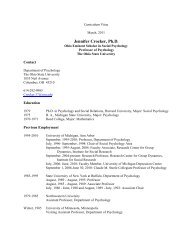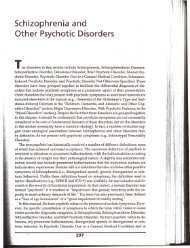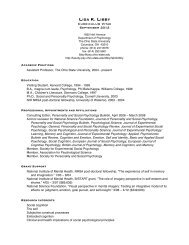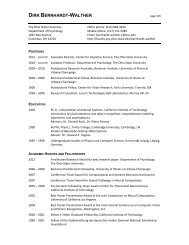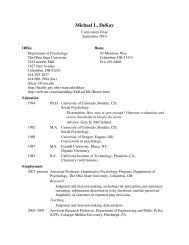Are personality traits important? - People
Are personality traits important? - People
Are personality traits important? - People
You also want an ePaper? Increase the reach of your titles
YUMPU automatically turns print PDFs into web optimized ePapers that Google loves.
Jean-Paul Sartre, “No Exit”<br />
• Three characters wait endlessly in a drawing room,<br />
each seeking self-definition from one another<br />
“So this is hell. I'd never have<br />
believed it. You remember all<br />
we were told about the<br />
torture-chambers, the fire<br />
and brimstone, the "burning<br />
marl." Old wive's tales! There's<br />
no need for red-hot pokers.
“... Hell is other<br />
people”<br />
--Jean Paul Sartre
Surviving the Social World<br />
• In Units One & Two, we discussed the how<br />
people survive the non-social world<br />
• In Unit Three, we will discuss four<br />
processes for surviving the social world:<br />
• Becoming a unique individual<br />
• Thinking about other people<br />
• Interacting with other people<br />
• Self-Knowledge
Questions to Address<br />
• Becoming a person–Personality Development<br />
• What is <strong>personality</strong>?<br />
• Do we need one?<br />
• Where does it come from?<br />
• How does it (and doesn’t it) change over time?
Questions to Address<br />
• Understanding others--Social Cognition<br />
• How do we develop an understanding of others’<br />
minds?<br />
• How do we make attributions about others from their<br />
behavior?<br />
• Dealing with others--Social Behavior<br />
• How do we change in the ways that we deal with<br />
others?<br />
• How does our concern for others’ judgments affect our<br />
actions?<br />
• Knowing yourself--Self-Esteem<br />
• Nature of self-esteem<br />
• Is self-esteem <strong>important</strong>?
Personality<br />
Honors Psychology
Exercise<br />
1. Describe a friend’s <strong>personality</strong><br />
2. What good are these characteristics?
Personality<br />
Personality refers to a person’s general manner of<br />
interacting with the world, especially with other<br />
people.<br />
whether one is vulnerable or hardy,<br />
sociable or reserved,<br />
imaginative or unimaginative,<br />
cooperative or uncooperative,<br />
reliable or undependable.
Personality<br />
Personality <strong>traits</strong> refer to enduring individual<br />
differences in the tendency to behave, think, and feel<br />
in certain consistent (that is, cross-situational) ways.<br />
For example, a professor may be late to class one day-there’s<br />
nothing to say about her <strong>personality</strong> from that<br />
specific behavior.
Personality<br />
BUT<br />
when she’s late nearly every day,<br />
for all the courses she teaches,<br />
and late for most events,<br />
late in paying her bills,<br />
late in returning phone calls,<br />
then we might describe her as tardy (a surface trait).
Personality<br />
• If we learn further that<br />
• she is sloppy in most of her work<br />
• careless in many other activities,<br />
• makes promises she never keeps<br />
• unreliable in other ways,<br />
• gives up easily on all sorts of tasks<br />
• can never decide what she wants to do next on all<br />
sorts of activities, then<br />
• we describe her as undirected (a central trait).
Is this fair?<br />
“<strong>Are</strong>n’t we just labeling people?”<br />
“Isn’t all this subjective?”<br />
“Isn’t it bad to judge people?”<br />
It depends<br />
<strong>Are</strong> <strong>personality</strong> <strong>traits</strong> real?<br />
Do <strong>personality</strong> <strong>traits</strong> affect behavior?
<strong>Are</strong> central <strong>traits</strong><br />
REAL?
<strong>Are</strong> <strong>personality</strong> <strong>traits</strong> real?<br />
Kenrick & Funder (1988) found<br />
observers agree to a substantial degree in the <strong>traits</strong> they<br />
assign to other people<br />
observers don’t just agree about which alleged <strong>traits</strong> go<br />
with which, but also about to whom these <strong>traits</strong> apply<br />
observers reliably differentiate people even on relatively<br />
common <strong>traits</strong><br />
observers increasingly agree with each other the longer<br />
they have known the person and these ratings<br />
increasingly correlate with the person’s actual behavior<br />
observers’ ratings are just as reliable whether they know<br />
one another or are strangers.
Personality Traits<br />
<strong>Are</strong> <strong>personality</strong> <strong>traits</strong> reliable?<br />
Costa & McCrae (1994) found that<br />
even when <strong>personality</strong> tests are administered 30 to 40<br />
years apart, they still correlate between +.50 and +.70.
<strong>Are</strong> central <strong>traits</strong><br />
IMPORTANT?
<strong>Are</strong> <strong>personality</strong> <strong>traits</strong><br />
<strong>important</strong>?<br />
Personality <strong>traits</strong> cross-cut other ways of<br />
categorizing people.<br />
For example, men differ more among themselves in<br />
curiosity than they differ from women, and women<br />
differ more among themselves in curiosity than they<br />
differ from men.<br />
All groups are made up of people who are extremely<br />
curious and people who wouldn’t care if you told<br />
them that the moon is made of green cheese.
<strong>Are</strong> <strong>personality</strong> <strong>traits</strong><br />
<strong>important</strong>?<br />
Personality <strong>traits</strong> cross-cut situations.<br />
That is, people behave similarly across many different<br />
situations.<br />
Even when situation differences in behavior are large<br />
(for example, how you act in a bar vs. Thanksgiving<br />
dinner), <strong>personality</strong> differences are just as large.
<strong>Are</strong> <strong>personality</strong> <strong>traits</strong><br />
<strong>important</strong>?<br />
Personality <strong>traits</strong> are <strong>important</strong> for surviving in the real<br />
world<br />
Productiveness: Barrick & Mount (1991) found that<br />
<strong>personality</strong> differences account for job performance<br />
differences even beyond IQ differences.
<strong>Are</strong> <strong>personality</strong> <strong>traits</strong><br />
<strong>important</strong>?<br />
Personality <strong>traits</strong> are <strong>important</strong> for surviving in the real<br />
world<br />
Romance: Buss (1996) found that conscientious spouses<br />
were less likely to have affairs than undirected spouses, and<br />
antagonistic spouses were more likely to become aggressive<br />
toward sexual rivals than agreeable spouses.
<strong>Are</strong> <strong>personality</strong> <strong>traits</strong><br />
<strong>important</strong>?<br />
Personality <strong>traits</strong> are <strong>important</strong> for surviving in the real<br />
world<br />
Health: Friedman et al. (1995) found that <strong>personality</strong><br />
differences are related to risk- and health-promoting<br />
behaviors.<br />
Finding Criminals: Caspi et al (1994) found that the same<br />
<strong>personality</strong> differences are related to delinquency in different<br />
countries, different generations, and different races.
So what are these<br />
central <strong>traits</strong>?
Early Trait Theories<br />
Extraverted<br />
Introverted<br />
Emotionally<br />
Unstable<br />
(Neurotic)<br />
Emotionally<br />
Stable<br />
Moody<br />
Anxious<br />
Rigid<br />
Sober<br />
Pessimistic<br />
Reserved<br />
Unsociable<br />
Quiet<br />
Passive<br />
Careful<br />
Thoughtful<br />
Peaceful<br />
Controlled<br />
Reliable<br />
Even-tempered<br />
Calm<br />
Touchy<br />
Restless<br />
Aggressive<br />
Excitable<br />
Changeable<br />
Impulsive<br />
Optimistic<br />
Active<br />
Sociable<br />
Outgoing<br />
Talkative<br />
Responsive<br />
Easygoing<br />
Lively<br />
Carefree<br />
Leadership<br />
Introverted-<br />
Stable<br />
Introverted-<br />
Neurotic<br />
Extraverted-<br />
Stable<br />
Extraverted-<br />
Neurotic
The Big Five<br />
Openness to experience-nonopenness<br />
Conscientiousness-undirectedness<br />
Extroversion-introversion<br />
Agreeableness-antagonism<br />
Neuroticism-stability
Where do our<br />
personalities come<br />
from?
The Origin of Personality<br />
In adults, <strong>personality</strong> differences show up most<br />
clearly in situations that are<br />
novel<br />
ambiguous<br />
stressful<br />
involve life transitions.<br />
In these situations, “the reticent become withdrawn,<br />
the irritable become aggressive, and the capable<br />
take charge.”<br />
Examples: early puberty in girls, going to college, and<br />
losing a job
The Origin of Personality<br />
Infants also differ in how they react to novel, ambiguous,<br />
and stressful situations.<br />
Reactions often correlate with many of the same outcomes<br />
predicted by <strong>personality</strong> factors:<br />
infants’ negative reactions to novelty, for example, predicted<br />
their internalization of negative events (“This bad thing<br />
happened because I’m just bad”) in middle childhood;<br />
infants’ negative emotionality predicted their internalization<br />
and “acting out” in middle childhood.
The Origin of Personality<br />
Researchers are now attempting to link temperament<br />
differences in infancy with <strong>personality</strong> <strong>traits</strong>:<br />
Activity (energy level) seems to be positively related to<br />
extraversion and negatively related to agreeableness and<br />
conscientiousness.<br />
Inhibition (fearfulness, shyness, withdrawal) seems to be<br />
positively related to neuroticism and negatively related to<br />
extraversion.<br />
Persistence (attention span, distractibility, interest) seems to<br />
be positively related to agreeableness, conscientiousness,<br />
and openness to experience.
The more <strong>personality</strong> changes...<br />
How our personalities change:<br />
Between the late teens and 30 years old, people<br />
typically become<br />
less neurotic,<br />
less extroverted,<br />
more conscientious, and<br />
more agreeable.
...the more it stays the same.<br />
How we stay the same:<br />
Example--Fear of new people<br />
Infants who are more frightened by new people<br />
and situations remain so in middle childhood<br />
and adolescence.<br />
Fear of new people and situations in middle<br />
childhood were correlated with the likelihood of<br />
living with one’s parents in young adulthood.
Temperament & Personality<br />
Temperamental differences don’t act alone to create<br />
personalities.<br />
<strong>People</strong> interpret and react to different temperaments<br />
differently, often in accordance with who the child is in<br />
the family and what sex the child is.
Family Roles<br />
Sibling rivalry: Finding a niche<br />
Split-parent identification is stronger among sibs raised<br />
together and stronger in same-sex sibs<br />
First borns dominate and care for their younger sibs, and<br />
they also have a greater interest in preserving the status<br />
quo.<br />
Compared to later borns, first borns are<br />
less open to new experiences but more responsible,<br />
achievement-oriented, and organized than later-borns;<br />
less agreeable, more jealous, more fearful, more<br />
assertive, more dominant, and less sociable.
Gender Differences<br />
Infants are already being treated in gender-specific ways<br />
according to their sex<br />
Fathers describe girl newborns as soft, small, and beautiful, boy<br />
newborns as firm, strong, an d well coordinated.<br />
Mothers who were asked to hold an infant (variously dressed as a girl<br />
named “Beth” and as a boy named “Adam”) talked more to Beth than<br />
Adam, and gave Adam more direct gazes unaccompanied by talk.<br />
Later, adults give aid and comfort to girls while expecting boys<br />
to be self-reliant.<br />
For example, college students were quicker to call for help if the<br />
crying infant was a girl rather than a boy.<br />
When two-year-olds were given a problem-solving task, mothers<br />
were more likely to aid their daughters than their sons.<br />
Children themselves actively promote sex-segregated play,<br />
especially for boys.
Identity & Adolescence<br />
• Trading Parents?<br />
• In the transition to adulthood,<br />
• Adolescents demonstrate more emotional autonomy from<br />
parents: they feel more independent and idealize them less.<br />
• Adolescents demonstrate less emotional autonomy from their<br />
peers and their resistance to peer pressure plummets from fifth to<br />
eighth grade.<br />
• In both industrial and hunter-gatherer societies, teen males join<br />
their peers in such dangerous behavior as getting in fights,<br />
irresponsible driving or--in hunter-gatherer societies--climbing<br />
trees too fast.<br />
• young men, for example, drive much more recklessly than<br />
otherwise when another young man is the passenger<br />
• young women do not seem to be influenced by young women<br />
passengers.
Is social behavior<br />
determined only by<br />
<strong>personality</strong>?
Beyond Traits<br />
Social/Cognitive Approach<br />
Humanistic Approach<br />
Psychodynamic Approach
Social-Cognitive Perspective<br />
Based on research on learning, cognition, and social<br />
influence<br />
Focuses on beliefs and habits that increase or decrease<br />
people’s ability to take control of their lives and<br />
accomplish goals
Social-Cognitive Perspective<br />
Locus of Control<br />
proposed by Julian Rotter<br />
belief that rewards either are or are not controllable by<br />
one’s own efforts<br />
may be internal or external
Social-Cognitive Perspective<br />
Self-Efficacy<br />
proposed by Albert Bandura<br />
belief about one’s ability to perform specific tasks<br />
can be high or low
Social Cognition<br />
Beyond Traits<br />
Differences in cognitive processing also play a large role<br />
in <strong>personality</strong><br />
E.g., delay of gratification
Delay of Gratification
Delay of gratification<br />
Self-control in 4- to 5-year-old children is highly<br />
correlated with adult competence<br />
• Ability to concentrate<br />
• Verbal fluency<br />
General competence<br />
•<br />
• Foresight<br />
•<br />
•<br />
•<br />
Gets rattled/immaturity under stress<br />
Low self-esteem<br />
Slow to make social contacts
Humanistic Perspective<br />
Focuses on the human tendency to create belief<br />
systems and to govern our lives in accordance with<br />
these beliefs<br />
Phenomenological reality - one’s conscious<br />
understanding of his/her world
Humanistic Perspective<br />
Carl Rogers’s person-centered approach<br />
self-concept is central to <strong>personality</strong><br />
conditional positive regard - love and praise is withheld<br />
unless one conforms to others’ expectations<br />
unconditional positive regard - accepting a person<br />
regardless of who they are or what they do
Humanistic Perspective<br />
Abraham Maslow<br />
hierarchy of needs<br />
self-actualization - the<br />
realization of one’s<br />
dreams and capabilities
Psychoanalytic Approach<br />
Developed by Sigmund Freud<br />
Psychoanalysis is both an<br />
approach to therapy and a<br />
theory of <strong>personality</strong><br />
Emphasizes unconscious<br />
motivation - the main causes of<br />
behavior lie buried in the<br />
unconscious mind
Rational,<br />
planful,<br />
mediating<br />
dimension<br />
of <strong>personality</strong><br />
Moralistic,<br />
judgmental,<br />
perfectionist<br />
dimension of<br />
<strong>personality</strong><br />
Irrational,<br />
illogical,<br />
impulsive<br />
dimension of<br />
<strong>personality</strong><br />
Psychoanalytic Approach<br />
Ego<br />
Id<br />
Conscious<br />
Superego Preconscious<br />
Unconscious<br />
Information<br />
in your<br />
immediate<br />
awareness<br />
Information<br />
which can<br />
easily be<br />
made<br />
conscious<br />
Thoughts,<br />
feelings,<br />
urges, and other<br />
information<br />
that is difficult<br />
to bring to<br />
conscious<br />
awareness
Divisions of the Mind<br />
Id - instinctual drives present at birth<br />
does not distinguish between reality and fantasy<br />
operates according to the pleasure principle<br />
Ego - develops out of the id in infancy<br />
understands reality and logic<br />
mediator between id and superego<br />
Superego<br />
internalization of society’s moral standards<br />
responsible for guilt
• Conscious - all<br />
things we are<br />
aware of at any<br />
given moment<br />
Psychoanalytic Approach<br />
Ego<br />
Id<br />
Conscious<br />
Superego Preconscious<br />
Unconscious
• Preconscious -<br />
everything that can,<br />
with a little effort, be<br />
brought into<br />
consciousness<br />
Psychoanalytic Approach<br />
Ego<br />
Id<br />
Conscious<br />
Superego Preconscious<br />
Unconscious
• Unconscious -<br />
inaccessible<br />
warehouse of<br />
anxietyproducing<br />
thoughts and<br />
drives<br />
Psychoanalytic Approach<br />
Ego<br />
Id<br />
Conscious<br />
Superego Preconscious<br />
Unconscious
Psychosexual Stages<br />
Freud’s five stages of <strong>personality</strong> development, each<br />
associated with a particular erogenous zone<br />
Fixation - an attempt to achieve pleasure as an adult in<br />
ways that are equivalent to how it way achieved in<br />
these stages
Oral Stage (birth - 1 year)<br />
Mouth is associated with sexual pleasure<br />
Weaning a child can lead to fixation if not handled<br />
correctly<br />
Fixation can lead to oral activities in adulthood
Anal Stage (1 - 3 years)<br />
Anus is associated with pleasure<br />
Toilet training can lead to fixation if not handled<br />
correctly<br />
Fixation can lead to anal retentive or expulsive<br />
behaviors in adulthood
Phallic Stage (3 - 5 years)<br />
Focus of pleasure shifts to the genitals<br />
Oedipus or Electra complex can occur<br />
Fixation can lead to excessive masculinity in males and<br />
the need for attention or domination in females
Latency Stage (5 - puberty)<br />
Sexuality is repressed<br />
Children participate in hobbies, school and same-sex<br />
friendships
Genital Stage (puberty on)<br />
Sexual feelings re-emerge and are oriented toward<br />
others<br />
Healthy adults find pleasure in love and work, fixated<br />
adults have their energy tied up in earlier stages



